This document discusses operationalizing Sun Tzu's Art of War strategies for business excellence in Malaysian manufacturing industries. It reviews literature on applying Sun Tzu's military strategies to business and identifies gaps in empirically testing dimensions. The study aims to develop measurable dimensions representing Sun Tzu's strategies for manufacturers. A model is tested using survey data from 300 firms and statistical analysis supports four key dimensions: employee motivation, market knowledge, strategic planning, and effective leadership.
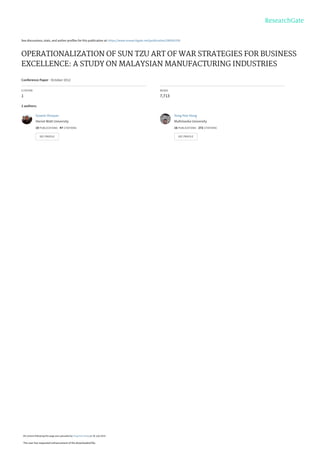


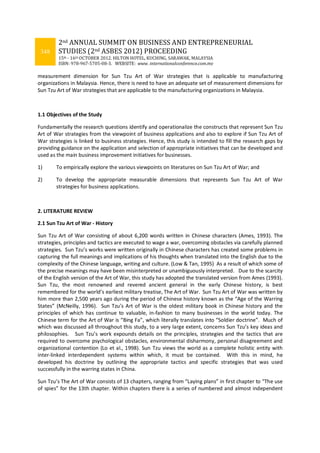

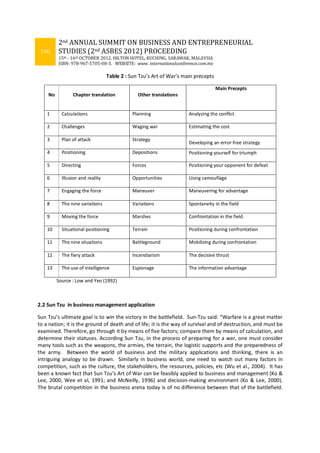


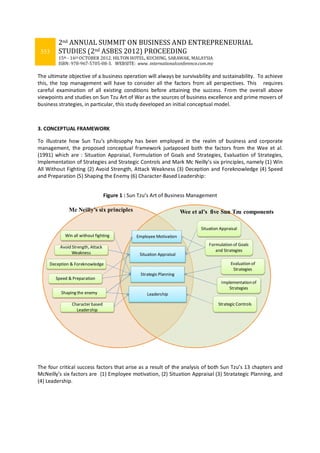
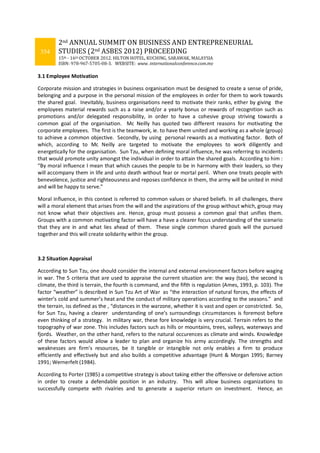
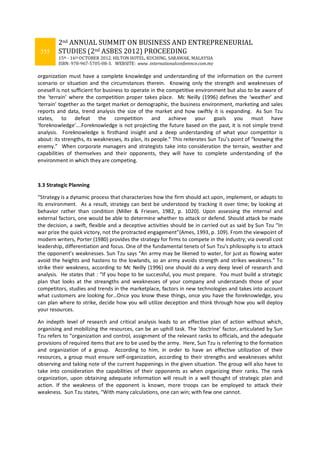

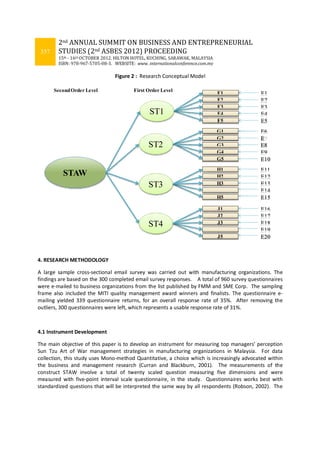

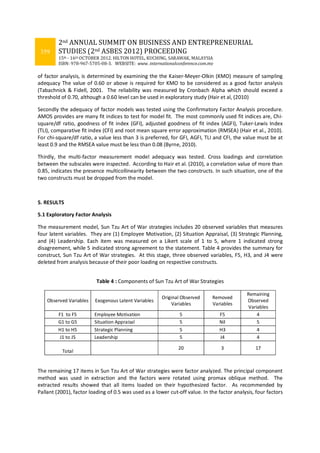
![360
2nd ANNUAL SUMMIT ON BUSINESS AND ENTREPRENEURIAL
STUDIES (2nd ASBES 2012) PROCEEDING
15th - 16th OCTOBER 2012. HILTON HOTEL, KUCHING, SARAWAK, MALAYSIA
ISBN: 978-967-5705-08-3. WEBSITE: www. internationalconference.com.my
with eigenvalues greater than 1.0, were extracted and the total variance explained was 61 percent in the
17 items.
Table 5 : KMO and Bartlett’s Test for STAW
KMO and Bartlett's Test
Kaiser-Meyer-Olkin Measure of Sampling Adequacy. .863
Bartlett's Test of Sphericity Approx. Chi-Square 2548.730
Df 136
Sig. .000
The Kaiser-Meyer-Olkin (KMO) value was 0.863, indicating sufficient inter-correlations (Table 5). The
Bartlett’s Test of Sphericity was significant [χ2 (136)=2548.73, p<0.001]. The diagonals of the anti-image
correlation matrix were all over 0.6, supporting the inclusion of each item in the factor analysis and
therefore it is clear that factor analysis is suitable for this data set. In reliability analyses, the Cronbach’s
alpha values are provided in the last column of Table 6. All the values are more than 0.7 indicating that
the measure was reliable.
Table 6: Results from Factor Analysis for Sun Tzu Art of War Strategies
Items
Employee
Motivation
Situational
Appraisal Strategic Planning Leadership
Cronbach’s
alpha
F3 .846 0.796
F2 .832
F1 .710
F4 .627
G4 .824 0.829
G2 .804
G3 .781
G5 .755
G1 .690
H2 .846 0.841
H1 .795
H4 .777
H5 .770
J1 .817 0.830
J2 .751
J3 .746
J5 .713](https://image.slidesharecdn.com/1292ndasbes2012proceeding-221219212337-a82f1eea/85/Research-Gate-Sun-Tzu-16-320.jpg)

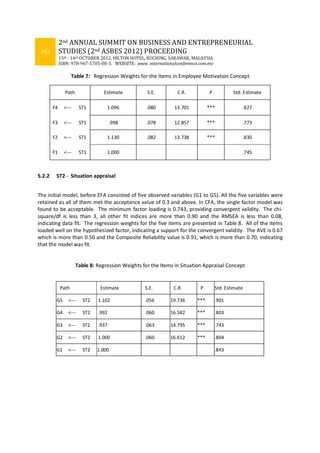
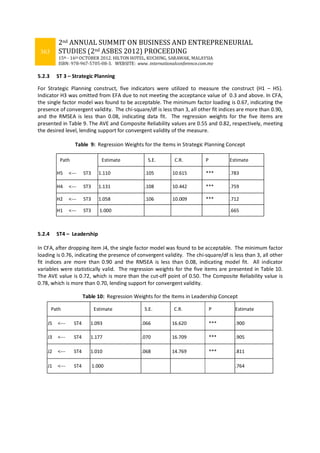
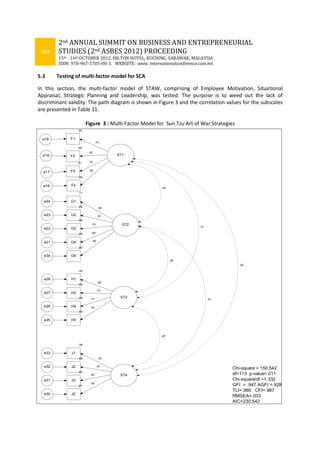

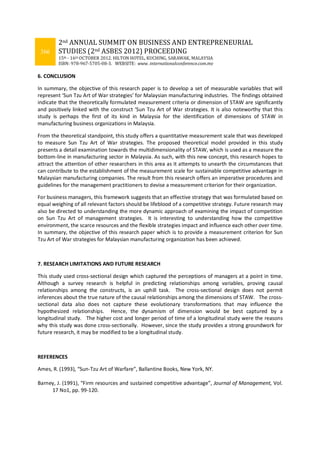
![367
2nd ANNUAL SUMMIT ON BUSINESS AND ENTREPRENEURIAL
STUDIES (2nd ASBES 2012) PROCEEDING
15th - 16th OCTOBER 2012. HILTON HOTEL, KUCHING, SARAWAK, MALAYSIA
ISBN: 978-967-5705-08-3. WEBSITE: www. internationalconference.com.my
Chih., W.C. (2003), Recreating Sun Tsu’s “Art of War” as a Strategy-oriented Balanced Scorecard for
Business, The Chinese Management Review, Committee on China Research and Development,
Faculty of Business Administration, The Chinese University of Hong Kong, Vol. 6, No. 1.
Forster, J.B.M (1996), Principles in Strategic Management, Macmillan, Melbourne.
Hunt, Shelby D. & Robert M. Morgan. 1995. "The Comparative Advantage Theory of Competition."
Journal of Marketing 59 (April): 1-14.
Krause, D.G. (1996), Sun Tzu: The Art of War for Executives, Nicholas Brealey, London
Ko, A.S.O. & Lee, S.F. (2000), “Implementing the strategic formulation framework for the banking
industry of Hong Kong”, Managerial Auditing Journal, Vol. 15 No. 9, pp. 469-77.
Kolar, T. & Toporisic, A. (2007), Point of view: Marketing as warfare, revisited., Marketing Intelligence &
Planning, Vol. 25 No. 3, 2007, pp. 203-216, Emerald Group Publishing Limited 0263-4503 (DOI
10.1108/02634500710747725)
Lee, S.F. & Ko, A.S.O. (2000), Building balanced scorecard with SWOT analysis, and implementing ``Sun
Tzu's The Art of Business Management Strategies'' on QFD methodology, Managerial Auditing
Journal.15/1/2 [2000]
Lee, S. F., Roberts, P., Lau, W.S. & Bhattacharyya, S.K. (1998), ``Sun Tzu's The Art of War as business and
management strategies for world class business excellence evaluation under QFD methodology'',
Business Process Management Journal, Vol. 04 No. 2, pp. 96-113, ISSN: 1355-2503.
Lee, S.F., Roberts, P., Lau, W.S. & Bhattacharyya, S.K. (1997), ``The use of Chinese philosophies to assist
achievement of world-class business excellence'', CIRP International Symposium on Advanced
Design and Manufacture in the Global Manufacturing Era, August, pp. 21-22.
Lo, V.H.Y., Ho, C.O. & Sculli, D. (1998), “The strategic insights of Sun Tzu and quality management”, The
TQM Magazine, Vol. 10 No. 3, pp. 161-8.
Low, S.P. & Tan, M.C.S. (1995), “A convergence of Western marketing mix concepts and oriental
strategic”, Marketing Intelligence & Planning, Vol. 13 No. 2, 1995, pp. 36-46.
Low, S.P. & Yeo, K.K. (1992), Sun Tzu’s Art of War and Its Strategic Relevance for Construction Project
Management, RICS research paper No. 25, Royal Institute of Chartered Surveyors, London.
McNeilly, M. (1996), Sun Tzu and Art of Business, Oxford University Press, New York, NY.
Miller, M. & Friesen, P. H. (1982) Innovation in Conservative and Entrepreneurial Firms: Two Models of
Strategic Momentum, Strategic Management Journal, Vol. 3, No. 1 (Jan. - Mar., 1982), pp. 1-25
Porter, M.E. (1985), “Competitive Advantage: Creating and Sustaining Superior Performance,](https://image.slidesharecdn.com/1292ndasbes2012proceeding-221219212337-a82f1eea/85/Research-Gate-Sun-Tzu-23-320.jpg)
